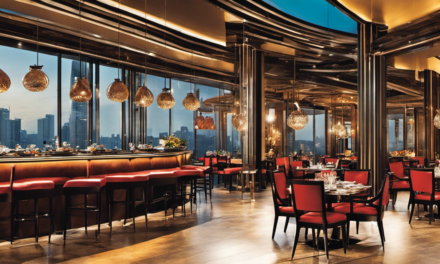Mastering the Art of Formal Dining Etiquette in Singapore
Navigating the sophisticated world of formal dining in Singapore can seem like a challenging task. Whether it's a high-stakes business lunch, an extravagant wedding, or an exclusive celebratory dinner– possessing a polished understanding of formal dining etiquette is undeniably crucial. This comprehensive guide will equip you with the essential knowledge required to impress your guests at your next formal event. Covering an array of topics from table settings, the correct use of utensils, ways to engage in conversation and more, by the end of this guide you'll be well-versed in the art of fine dining.
Understanding the Importance of Dining Etiquette
In the realm of formal dining, it's not just about indulging in culinary delights. It's about crafting an unparalleled experience that leaves a lasting impression on your guests. Good manners and etiquette are the cornerstones of any sophisticated event, making guests feel valued and appreciated. Not only does familiarity with the rules ensure a stress-free atmosphere, but it also averts any potential faux pas that could be embarrassing.
The Framework of a Formal Dining Setup
A sense of ceremony surrounds the way a table is set for a formal dining event. The following are the essentials you'll need:
- Tablecloth and Napkins: An impeccably clean and wrinkle-free tablecloth is mandatory. Napkins should be placed on the left side of the plate, either neatly folded or held in a napkin ring.
- Plates: The central plate holds the prime position in the centre, while the bread plate is to the left and drinks glass situated to the right.
- Cutlery: Set out the utensils in the order in which they'll be used, with the one to be used first on the outside. For instance, the fork stays on the left, the knife on the right (with the blade facing the plate), and the spoons aligned to the right of the knife.
- Glassware: Place the water glass closest to the plate and the wine glass right next to it.
- Centrepiece: Opt for a centrepiece that complements the setting and doesn't obstruct guests' view. Floral arrangements or a fruit bowl are popular choices.
The correct use of utensils can be a sticking point for many. Here's how to ace it:
- Forks: Hold the fork with the tines pointing downwards, using your index finger and thumb for grip while keeping the rest of your fingers relaxed.
- Knives: Place your index finger on the top of the blade and your thumb on the bottom of the handle. Use a gentle sawing motion, rather than pressure, to cut the meat.
- Spoons: Hold the spoon with your index finger on the top of the handle and your thumb at the bottom. The purpose of a spoon is to scoop food towards your mouth.
When it comes to dessert, the forks and spoons are often smaller and uniquely shaped. Dessert forks typically have a broader set of tines while the spoon is generally smaller.
Understanding the Importance of Dining Etiquette
Knowing the ins and outs of formal dining etiquette in Singapore isn't merely about pretending to be posh at the table. Its significance goes way beyond that, setting the stage for an immersive and unforgettable dining experience.
Formal dining etiquette transcends the act of simply savouring delectable meals. It's a crucial part of creating a memorable event where guests can thoroughly enjoy themselves, feeling appreciated and respected. A comprehensive understanding of the etiquette rules fosters a relaxed and enjoyable atmosphere, eliminating any chances of awkward situations spurred by unfamiliarity with dining norms.
Some might view these etiquettes as old-fashioned and unnecessary, but their importance cannot be underestimated. Here are a few reasons why:
-
Fosters Respect and Courtesy: An understanding of formal dining etiquettes demonstrates respect for the host, other guests, and the event itself. It shows that you value their time and effort, fostering an atmosphere of mutual respect and courtesy.
-
Promotes Positive Impression: Displaying good table manners reflects a part of your personality. It helps create a positive impression, making others more likely to view you as considerate and well-bred.
-
Facilitates Smooth Dining: Knowing the correct etiquette helps you navigate the dining process seamlessly, avoiding potential embarrassment or confusion.
It's essential to keep in mind that these etiquettes vary across cultures and societies, but their core aim remains the same – to ensure a comfortable and harmonious dining experience for everyone present.
Now that we've set the stage for the importance of formal dining etiquette, let's dive deeper into the specifics, starting with the foundation of any formal dining setting – the table setup.
[Next Part: The Framework of a Formal Dining Setup]
The Framework of a Formal Dining Setup
A finely set dining table is the first impression your guests will get and is crucial in setting the tone for the evening. Here's how to nail your table setup in line with proper formal dining etiquette in Singapore:
Table Settings Essentials
Discover the elements you need to consider while setting up a formal dining table:
- Tablecloth and Napkins: A neat and clean tablecloth is the cornerstone of every formal table setting. Also, napkins should always be impeccably clean and ideally be placed on the left side of the plate, either neatly folded or placed inside a napkin ring.
- Plates: The central plate should be positioned in the middle, the bread plate to the left, and the drinks glass to the right.
- Cutlery: Many diners find this part tricky. But remember, utensils should be arranged in the order of their use, with the outermost ones used first. The setup is usually – fork on the left, knife on the right (blade facing inwards), and spoons to the right of the knife.
- Glassware: Glasses are typically positioned to the right, with the water glass closest to the plate and the wine glass beside it.
- Centrepiece: A tastefully chosen centrepiece can dramatically enhance the visual appeal of your table setting. It could range from a minimalistic floral arrangement to a carefully crafted fruit bowl.
Mastering the Use of Utensils
While setting up the table is crucial, knowing how to use the cutlery correctly is equally important.
- Forks: Gripped between the index finger and thumb with other fingers comfortably curled around the handle. Fork tines should face downwards.
- Knives: Use the index finger on top of the blade while the thumb supports from the bottom, with other fingers gripping the handle. Remember, it's about a gentle sawing motion, not about exerting pressure.
- Spoons: The spoon is held with the index finger on top and the thumb at the bottom of the handle.
- Dessert Utensils: Dessert forks and spoons are usually smaller with a unique shape. Typically, the fork has wider tines, while the spoon is smaller.
Understanding the proper framework of the dining setup and the basics of using cutlery goes a long way in helping you feel confident and relaxed at any formal dining event. Armed with these skills, you're well on your way to mastering the art of formal dining etiquette in Singapore.
[Next Part: The Principle of Conduct: Key Dos and Don'ts of Formal Dining Etiquette]
The Principle of Conduct: Key Dos and Don'ts of Formal Dining Etiquette
Mastering the formal dining etiquette in Singapore goes beyond the table setup and using utensils correctly; it also involves understanding the dos and don'ts of conduct during the dining process.
- Seating Arrangements
The seating arrangement can often set the tone for a formal dinner. The host usually assigns seats based on factors such as age, gender, and hierarchy. As a guest, it is respectful to wait for the host to be seated first before taking your seat.
- Conversational Skills
Being adept at conversation is a significant part of formal dining etiquette. It's essential to engage in pleasant, stimulating conversation, while sidestepping potentially controversial topics such as politics or religion. Always remember to chew and swallow your food before speaking, and refrain from interrupting others while they're talking.
- Host and Guest Responsibilities
Both the host and guests have certain responsibilities to make the event enjoyable. The host’s job is to make guests feel comfortable, ensuring everyone has sufficient food and drink, and even possibly making introductions among guests.
Guests, in turn, should show appreciation and respect towards the host and other guests. It's good practice to RSVP promptly, arrive on time, and thank the host before leaving.
Remember, the purpose of these rules isn't just about formality—it's also about ensuring everyone feels comfortable, respected, and able to enjoy the event without awkwardness or discomfort.
By understanding these key dos and don'ts, you will not only be able to navigate a formal dining situation with ease but also create a positive impression on your fellow diners.
[Next Part: Conclusion and Reflection]
Conclusion and Reflection
Over the course of this guide, we’ve journeyed into the depths of formal dining etiquette in Singapore, exploring its significance, key elements of a formal dining table setup, the appropriate handling of utensils, and the behavioural dos and don'ts at a formal dinner.
It's clear that understanding and following these principles can significantly elevate your dining experience. They not only create a favourable impression but also facilitate smooth social interaction, making dinner events engaging and memorable.
Mastering formal dining etiquette is a journey that takes practice and patience. However, the effort invested is worth the difference it will make at your next formal dining experience.
Let's take a quick recap of what we've learned:
- The importance of understanding formal dining etiquette and its role in creating memorable dining experiences.
- The essentials of a formal dining setup, including table settings and correct utilization of utensils.
- The conduct expected during a formal dining event including seating arrangements, conversation etiquette, and roles of guests and hosts.
Remember, mastering formal dining etiquette in Singapore is not just about following a list of rules, but about being considerate and respectful towards your fellow diners. By understanding and embracing these etiquettes, you'll be equipped to host or attend any formal dining event with elegance and grace, leaving a memorable impression on your guests.





